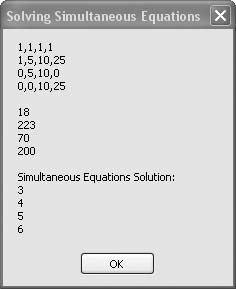Recipe 6.34. Solving Simultaneous Equations
ProblemYou want to solve a set of n simultaneous equations containing n unknowns. SolutionSample code folder: Chapter 06\Matrix Use the matrix operations presented in the MatrixHelper module to solve the equation. DiscussionMatrices are useful in solving simultaneous equations. The solution is defined in Cramer's Rule, a theorem of linear algebra named after mathematician Gabriel Cramer. (A full description of matrices and their operations is beyond the scope of this book.) The MatrixHelper module contains a special-purpose function that solves simultaneous equations by calling several matrix-analysis functions. You pass a square matrix of size n containing the coefficients of the unknowns from the equations, along with a one-dimensional array containing the equation constants. The MatrixHelper.SimultEq() function then returns a one-dimensional array containing the solution values for the equation's unknowns. Here is the code listing for the MatrixHelper.SimultEq() function: Public Function SimultEq( _ ByVal sourceEquations(,) As Double, _ ByVal sourceRHS() As Double) As Double() ' ----- Use matrices to solve simultaneous equations. Dim rowsAndCols As Integer ' ----- The matrix must be square and the array size ' must match. Dim rank As Integer = UBound(sourceEquations, 1) If (UBound(sourceEquations, 2) <> rank) Or _ (UBound(sourceRHS, 1) <> rank) Then Throw New Exception( _ "Size problem for simultaneous equations.") End If ' ----- Create some arrays for doing all of the work. Dim coefficientMatrix(rank, rank) As Double Dim rightHandSide(rank) As Double Dim solutions(rank) As Double Dim rowPivots(rank) As Integer Dim colPivots(rank) As Integer ' ----- Make copies of the original matrices so we don't ' mess them up. Array.Copy(sourceEquations, coefficientMatrix, _ sourceEquations.Length) Array.Copy(sourceRHS, rightHandSide, sourceRHS.Length) ' ----- Use LU decomposition to form a triangular matrix. coefficientMatrix = FormLU(coefficientMatrix, _ rowPivots, colPivots, rowsAndCols) ' ----- Find the unique solution for the upper-triangle. BackSolve(coefficientMatrix, rightHandSide, solutions, _ rowPivots, colPivots) ' ----- Return the simultaneous equations result in ' an array. Return solutions End Function For example, say you have a pile of 18 coins comprised of pennies, nickels, dimes, and quarters totaling $2.23. The nickels and dimes total $.70, and the dimes and quarters total $2.00. The unknowns are the numbers of each of the four types of coins. The given information provides all you need to solve a set of four equations with four unknowns:
The following code sets up the 4 x 4 matrix of coefficients and the array of constants, then passes these two arrays to MatrixHelper.SimultEq() to solve for the four unknowns: Dim matrixA(,) As Double = { _ {1, 1, 1, 1}, _ {1, 5, 10, 25}, _ {0, 5, 10, 0}, _ {0, 0, 10, 25}} Dim arrayB() As Double = {18, 223, 70, 200} Dim arrayC() As Double = _ MatrixHelper.SimultEq(matrixA, arrayB) MsgBox(MatrixHelper.MakeDisplayable(matrixA) & vbNewLine & _ vbNewLine & MatrixHelper.MakeDisplayable(arrayB) & _ vbNewLine & vbNewLine & _ "Simultaneous Equations Solution:" & _ vbNewLine & MatrixHelper.MakeDisplayable(arrayC)) As shown by the results displayed in Figure 6-34, there are three pennies, four nickels, five dimes, and six quarters in the pile. Figure 6-34. Solving a set of four equations with four unknowns The MatrixHelper.SimultEq() function is listed in the MatrixHelper module code, presented in the next recipe. See AlsoSee the full MatrixHelper.vb listing in Recipe 6.35. |
EAN: 2147483647
Pages: 400